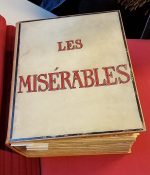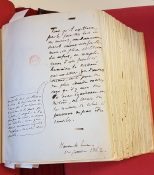I was honored to be invited to film an in-depth interview for the documentary “L’aventure des manuscrits” with the Paris-based documentary film company Little Big Story. Since travel restrictions kept me from Paris, the director, Anne-Sophie Martin, sent a French film crew to Charlottesville from New York in late October. She and a Little Big Story colleague joined us via Zoom, and we filmed on stage at The Paramount Theater downtown, such a lovely setting for Victor Hugo’s forward-thinking ideas in Les Misérables.
 It was — you can imagine! —delightful to spend ninety minutes talking about Hugo’s work for a better world. TheFrench version of the documentary was screened in September 2021 on ARTE, the European culture TV channel. Others interviewed for the segment on Les Misérables include Sorbonne University professors Florence Naugrette and Jean-Marc Hovasse, Maison de Victor Hugo director Gérard Audinet, and Hugo specialist at the Bibliothèque nationale de France, Thomas Cazentre. Since ARTE’s policy is to film guests in their native language, I spoke in English. It is expected that this document will eventually be disseminated in North America, in English.
It was — you can imagine! —delightful to spend ninety minutes talking about Hugo’s work for a better world. TheFrench version of the documentary was screened in September 2021 on ARTE, the European culture TV channel. Others interviewed for the segment on Les Misérables include Sorbonne University professors Florence Naugrette and Jean-Marc Hovasse, Maison de Victor Hugo director Gérard Audinet, and Hugo specialist at the Bibliothèque nationale de France, Thomas Cazentre. Since ARTE’s policy is to film guests in their native language, I spoke in English. It is expected that this document will eventually be disseminated in North America, in English.
The program covers many marvelous aspects of the adventure of Hugo’s manuscript. Hugo wrote his novel over a seventeen-year period, from 1845 until 1862, with a twelve-year hiatus during his political exile. Florence Naugrette speaks about how Hugo’s friend, lover and muse, Juliette Drouet, shared with him her childhood convent experiences for his convent episodes (as did his shorter-term lover, Léonie d’Aunet Biard, who had been imprisoned in a convent for her adulterous affair with Hugo). A couple of Hugo’s fictional nuns are named after Juliette. In the film, we hear how Juliette brought Victor’s trunk of manuscripts to him in exile in Brussels while his wife Adèle packed the belongings they could take and sold the rest. And how the boat carrying this same trunk—still with the Les Misérables manuscript inside—came close to capsizing on the family’s journey from Brussels to Jersey, headed for their second exile home.
For my part, I was asked about the offspring of Hugo’s epic, especially the award-winning musical by Boublil and Schönberg, and what these progeny bring to people’s knowledge and understanding of Hugo’s novel. And about how Hugo’s themes resonate in today’s America, where social justice, conscience, and everyone’s humanity are burning  issues. Victor Hugo proved himself to be farseeing yet again with his goals for Les Misérables and his epigraph for it. Here’s that famous epigraph, first in Hugo’s French, then in Robert F. Cook’s translation for To Love Is to Act:
issues. Victor Hugo proved himself to be farseeing yet again with his goals for Les Misérables and his epigraph for it. Here’s that famous epigraph, first in Hugo’s French, then in Robert F. Cook’s translation for To Love Is to Act:
Tant qu’il existera, par le fait des lois et des mœurs, une damnation sociale créant artificiellement, en pleine civilisation, des enfers, et compliquant d’une fatalité humaine la destinée qui est divine; tant que les trois problèmes du siècle, la dégradation de l’homme par le prolétariat, la déchéance de la femme par la faim, l’atrophie de l’enfant par la nuit, ne seront pas résolus; tant que, dans de certaines régions, l’asphyxie sociale sera possible; en d’autres termes, et à un point de vue plus étendu encore, tant qu’il y aura sur la terre ignorance et misère, des livres de la nature de celui-ci pourront ne pas être inutiles.
As long as through the workings of laws and customs there exists a damnation-by-society which artificially creates hell in the very midst of civilization and complicates destiny, which is divine, with a man-made fate; as long as the three problems of the age are not resolved: the debasement of men through proletarianization, the moral degradation of women through hunger, and the blighting of children by keeping them in darkness; as long as in certain strata social suffocation is possible; in other words and from an even broader perspective, as long as ignorance and poverty exist in this world, books like this one cannot be useless.
Permission was generously granted me to take these photos at the Bibliothèque nationale de France when my “Victor Hugo’s Paris” students and I were invited there.
